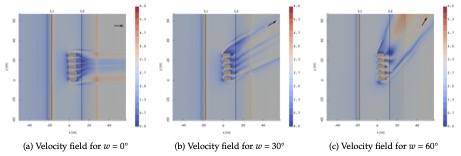Abstract
In the Netherlands, the coastal dunes are essential to protect the country against flooding. However, the rising sea levels increase the risk of flooding along these sandy shores. Moreover, due to a combination of human and natural activities, dune erosion has increased and will continue to do so in the coming decades. Besides flood protection, the Dutch shoreline is important for preserving biodiversity, the generation of drinking water and recreation. In recent year, the number of recreational buildings on the beach, such as bars and holiday homes has increased. This is relevant because previous studies show that such beach buildings affect the wind flow and limit aeolian transport of sediment towards the dunes.
This research studies the impact of beach house configurations on dune-ward sediment transport to limit the adverse effects on dune development. We use CFD simulations to study the wind flow around a 3D model of a beach with holiday houses, based on a section of the Noordwijk beach in the Netherlands. We implement the CFD software OpenFOAM to solve the RANS equations for turbulent, steady-state flow. The sediment transport that occurs is calculated using the wind direction and speed near the ground surface of the solution.
The study consists of multiple 3D models in which the placement of the houses is varied systematically, to study the effects of beach house configurations. Variations are made by rotating houses, individually or within a row, and changing the distance between the houses and dunes. We determine the annual effect on sediment transport by applying varying wind conditions based on historical wind data from Noordwijk. As we have many simulations to run, and all need different parameters and settings, we automated the process. First, a PostgreSQL database is used to store all requirements for the CFD simulations, the metadata and the results the simulations give. Then, a Python script links the information stored in the database to the correct settings in OpenFOAM. This way, many simulations are run in a row, and the results area to compare.
The results show that rotating the houses individually towards the prevailing wind direction appears to improve the amount of dune-ward sediment that takes place, compared to beach houses placed perpendicular to the shore. Rotating a row of houses as a whole has a limited effect on the amount of sediment transport. However, combining the rotation of the row of houses and the houses individually towards the prevailing wind direction shows the best improvement in sediment transport. Changing the distance between the houses and the dune foot so that a row of houses forms a funnel shape pointing towards the dunes also yields promising results. Because we use a simplified model and do not take factors such as moisture levels or fetch distance into account, the results of this study overestimate the amount of sediment transport that takes place and might not quite resemble the reality. Further research using scale models or wind tunnels is necessary to confirm the suggestions made in this thesis.
Main finding: combining the rotation of houses and the houses individually towards the prevailing wind direction improves the sediment transport. Also, funnel shapes can potentially help.
Main limitation: the study was purely numerical, and further cases compared with experiments are needed.
